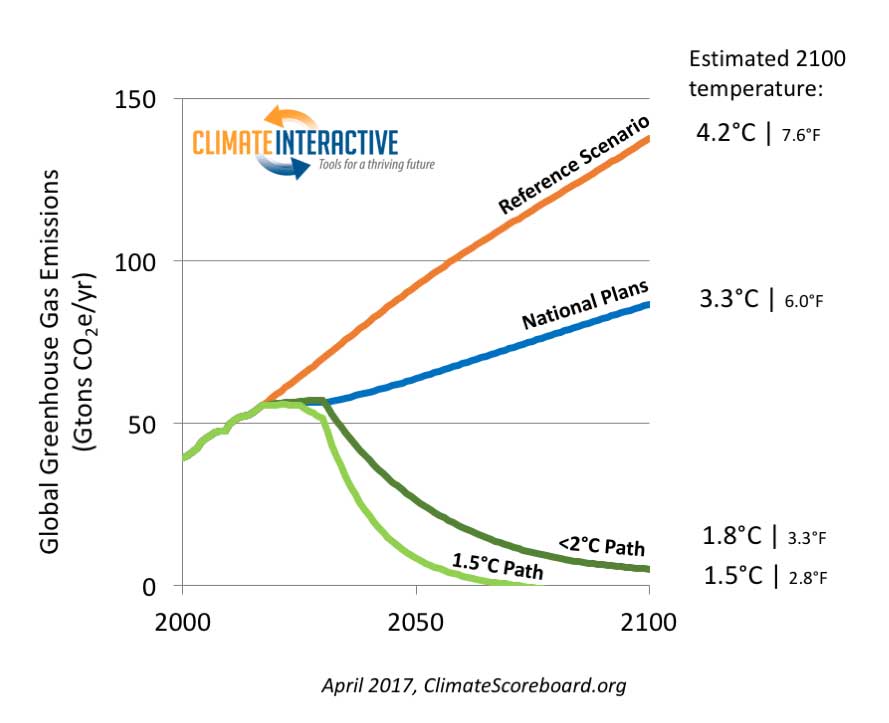The Paris Agreement was never designed to be a static commitment, but instead was structured to ratchet up the Nationally Determined contributions every five years.
Paris Agreement Terminology
Before we get into this, it is perhaps wise to first define what some of these Paris Agreement phrases actually mean. So with that thought in mind, here are several key terms …
- Intended Nationally Determined Contributions (INDCs) – Plans submitted to the UNFCCC before the country or member state ratified the Paris Climate Agreement.
- Nationally Determined Contributions (NDCs) – Plans submitted to the UNFCCC once the country or member state has ratified the Paris Agreement. In most cases when members ratified the Paris Agreement their INDCs became NDCs. Currently NDCs typically end in 2025 or 2030, however countries will be asked for additional NDCs in the coming years.
- Long-term Strategies (also called Mid-Century Strategies) – Proposals that communicate the decarbonization pathway a country aspires to follow out to 2050.
The Vital Importance of Ratcheting
Ramping up the currently agreed NDCs truly does matter. To illustrate why, here is a diagram via ClimateInteractive that illustrates the consequences of not doing so…
They have done some analysis using the C-ROADS climate policy simulator and created the above.
In essence, the blue line is the projection of what happens after implementing the current NDCs. There is of course no certainty here, it is simply a modelled projection and so it does have a range of uncertainty of 1.9 – 4.4°C.
What is rather obvious to most who are familiar with the details is that unless the NDCs are ratcheted up, then the currently agreed NDCs within the Paris Agreement will not be enough to achieve the declared goal of …
Holding the increase in the global average temperature to well below 2 °C above pre-industrial levels and to pursue efforts to limit the temperature increase to 1.5 °C above pre-industrial levels
What needs to Happen?
To get ourselves on the Dark Green line (the 2C path), CO2 emission must peak by 2030 and then reduce steadily. Developed nations would need to achieve a decrease of 5% per year and developing nations 3.5% per year.
To aim even higher for the Light Green line (the 1.5C path), CO2 emission must peak by 2025 and then reduce steadily by as much as 10% per year within developed nations (and also peak by 2030 in developing nations and then reduce by 8% per year).
ClimateInteractive have a video that lays it all out …
This is not a Surprise
The Paris Agreement itself makes all this rather clear, so none of this is a shock to anybody. The Paris Agreement adoption document very clearly lays this all out.
Paragraph 17 states …
17. Notes with concern that the estimated aggregate greenhouse gas emission levels in 2025 and 2030 resulting from the intended nationally determined contributions do not fall within least-cost 2 ̊C scenarios but rather lead to a projected level of 55 gigatonnes in 2030, and also notes that much greater emission reduction efforts will be required than those associated with the intended nationally determined contributions in order to hold the increase in the global average temperature to below 2 ̊C above pre-industrial levels by reducing emissions to 40 gigatonnes or to 1.5 ̊C above pre-industrial levels by reducing to a level to be identified in the special report referred to in paragraph 21 below
… hence the agreement has this five year ratcheting built into it, as defined within paragraphs 22 and 23 …
23. Urges those Parties whose intended nationally determined contribution pursuant to decision 1/CP.20 contains a time frame up to 2025 to communicate by 2020 a new nationally determined contribution and to do so every five years thereafter pursuant to Article 4, paragraph 9, of the Agreement;
24. Requests those Parties whose intended nationally determined contribution pursuant to decision 1/CP.20 contains a time frame up to 2030 to communicate or update by 2020 these contributions and to do so every five years thereafter pursuant to Article 4, paragraph 9, of the Agreement;
One Last Thought
There is in some minds an idea that the Paris Agreement solves the climate change problem. This is not correct. It’s a great start, and while it does establish a solid foundation, much more is needed.
It is not up to “them”. Instead it is up to us as individuals to be both willing and able to support the transition required.
